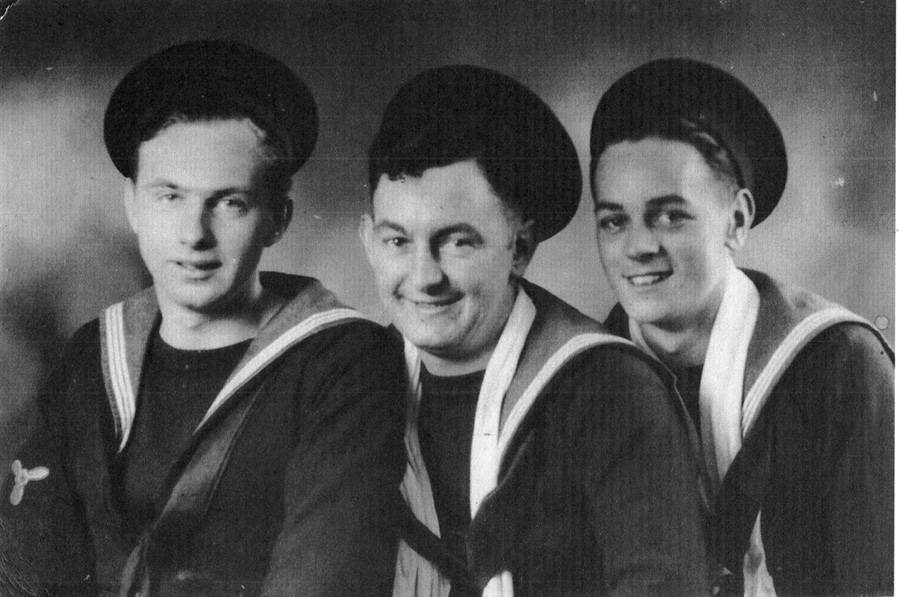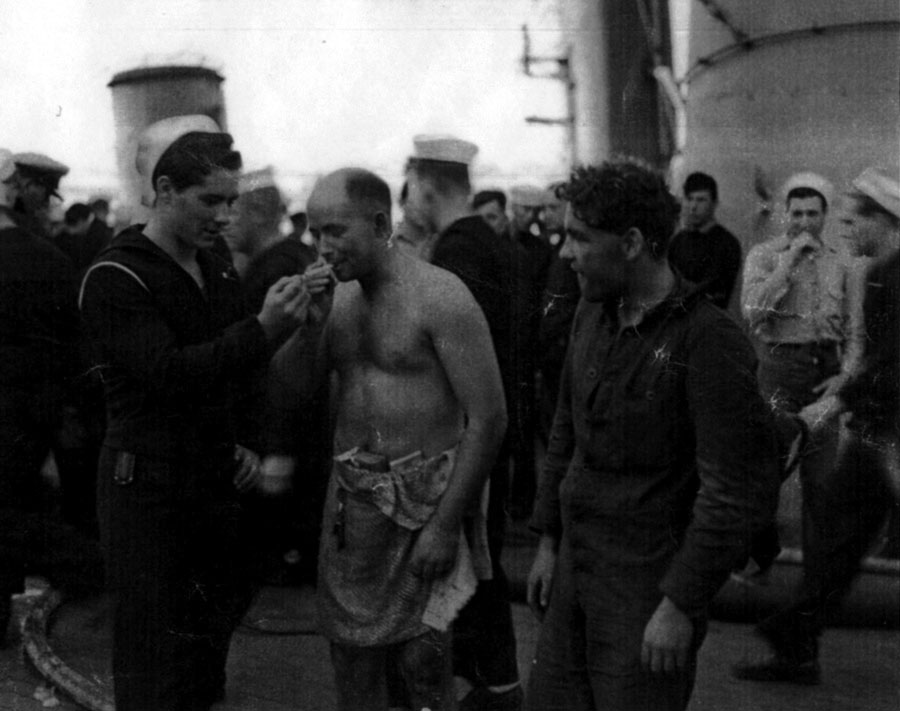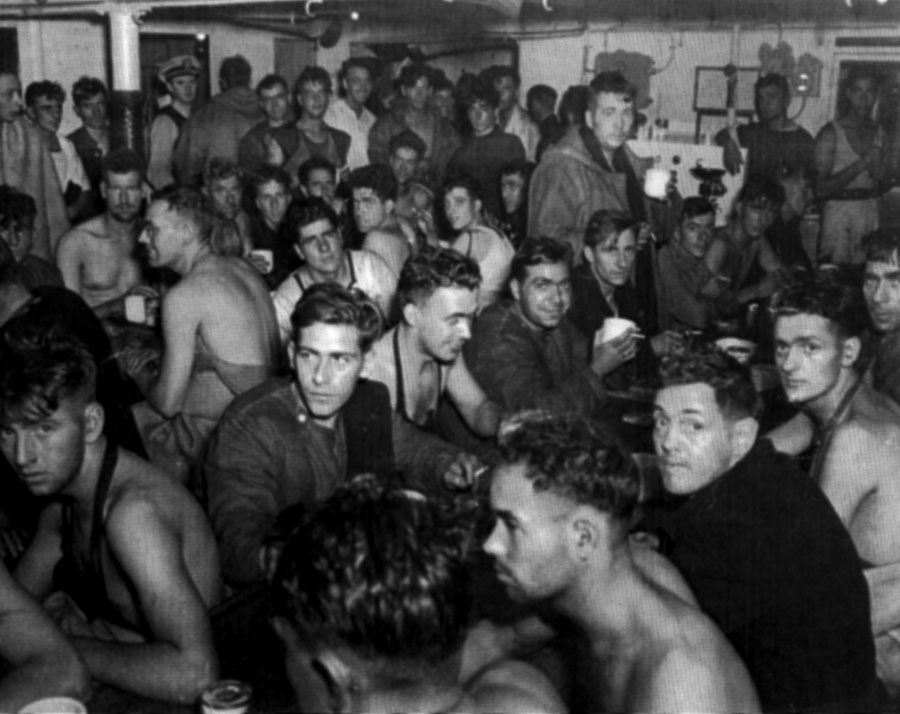






Norman Johns , one of 556 survivors of the sinking of HMS Hecla, formed The HMS Hecla, HMS Marne and HMS Venomous Association with Harry Cliffe and George Male in 1990 (the year the first edition of this book was published) to keep the survivors and their families in touch with each other and with the men who rescued them.
Norman's full name was Henry Norman Ernest Johns but he was always known as Norman. On leaving the Navy he started a yacht rigging business with his father, Fred "Pops" Johns, at the "Old Chandlery" at Instow on the opposite side of the river from Appledore in North Devon. He combined this with taking over the running of the centuries old ferry between Appledore and Instow as described by him on the Ferry's website. By 1982 he found his knees were playing up making it difficult to get in and out of the ferry so he sold the business but continued to run the Appledore and Instow Regatta which he started with Captain Vernon Harris in 1960. Norman lost part of his leg in August 2010 and he spent the last year of his life in a retirement home with his wife Pru. He "crossed the bar" on January 3rd 2016, aged 92 years, 73 years after Hecla was torpedoed off the coast of North Africa and his rescue by HMS Venomous.
On the 11 November 1992, the fiftieth anniversary of the loss of the Hecla,
some 200 members attended an anniversary service and dinner at
Stratford on Avon. He wrote his own memories of that night in 2008 and
brief extracts were included in the second edition of A Hard Fought Ship (2010). The full text of his memoir is given below.
*****
I joined the Royal Navy in September 1941 and was posted to HMS Hecla as a 2nd. class stoker while it was in Iceland in January 1942. HMS Hecla returned to the Clyde for a refit and storing and on the 15 April 1942 sailed in a large troop convoy for service in the Indian Ocean, On the 17 May she was severely damaged off the coast of South Africa by a German mine. She underwent repairs in the Royal Navy yard at Simonstown and was then ordered north to serve in the Med. After a short stop at Freetown she sailed again in the company of HMS Vindictive and an escort of two destroyers, HMS Marne and HMS Venomous.

On
the 11th. November I was in my hammock when a torpedo hit us at about
1100 to 1130. The ship was listing badly as I went to my action
station, the port forward damage and fire control party on the focsl.
Nobody else mustered, and I could see from the whaler hanging
out of the davits and the list that the ship was severely damaged. I
called up damage control on the telephone asking for
orders and permission to go below and put on more clothing as I
only had time to put on underpants and singlet when I left my hammock. This was
granted and I went down to the mess-deck to find my jersey and overalls
when another torpedo struck and I abandoned my search for clothes
and went up again to the well-deck where many of the crew were
gathered.
I
found my friend George Fortey from Gloucester and after a while another
torpedo struck and by this time the ship was listing to port and
obviously sinking. It was about this time that one of our escorts the
destroyer HMS Marne was hit.
George and I were standing on the port side of the well-deck and saw
the explosion, she was hit aft and the ready to use ammunition that was
stored in lockers on that part of the ship went up like a firework
display. At the 1992 Reunion I asked one of the men on Marne 'Where
were you when the torpedo struck' and, to my surprise, he
answered 'I was midships getting your CO and other officers
aboard'.
We never heard the abandon ship order, in fact I don't think
that there was one, so we debated what side we would go over. George
wanted to go over the port side as by this time the deck was only a few
feet from the water, but in the end we thought that the ship would roll
over that way, and if we were still near would roll on us so we decided
to go for the the starboard side. We
went over together, the side of the ship was almost horizontal and we slid
down the bottom and into the water. 1 didn't see George again after
this.
As I hit the water I went under but the buoyancy of my
lifejacket brought me to the surface and I started to swim away from
the ship. I then realised that I was being sucked back towards the
ship's side, and saw the hole the first torpedo had made, and as
much as I tried I couldn't stop myself from going in. I thought '"this
is the end" but I must have grasped a hanging rope. I
could hear the screams and shouts of others that had also been sucked in.
I must have struck something hard and become unconscious, and when I
came to I was well away from the ship and on my own.
After
a while I heard voices and made my way to a group on a Carley
float. The float was overcrowded and I hung onto one of the lines on
the outside and stayed there for I don't know how long. Venomous made several depth-charge attacks on the U Boat. These were felt by
me and I expect all the others that were in the water, it was as if I
was being put through a wringer and being squeezed from the legs upward. Finally, HMS Venomous came alongside to pick us up.
There were scrambling nets hanging over the side and many of the Carley float's
occupants left to grab the nets but I was on the far side so didn't
attempt to do so. The suddenness of all the men leaving made the float
capsize. At that moment, orders came from the Venomous
to get back on the float as she had "a ping". The destroyer moved
away, some of the men who had grabbed hold of the nets were
pulled aboard but many dropped into the water and were probably killed
by her propellers.
Anyway,
with a few others I managed to get aboard the capsized float and I
stayed there for the rest of the night. The air was cold, but the water
was warmer, there was a swell but the sea was not rough. When light
came there were only two of us left on the float. I don't know what
happened to the rest, we were on our own and expected Venomous
to appear and pick us up but she never did. We began to think we might not be picked up for some time and would
have to get to the water stored on the side of the float that
was now underwater; neither of us had a knife and we were wondering how
to right the float. To make matters worse there was a body trapped
underneath, probably someone who was trapped when the float capsized.
We were debating this when in the distance we saw an aircraft. It must
have spotted us as it came over, flew around us low and we saw an arm
wave from the window. It was an American flying boat, Catalina type.
We were heartened by this as we knew we were spotted and in
time help would arrive, and sure enough in the distance we saw Venomous returning. We were the last to be picked up.
As soon as we were aboard Venomous
I was given a tot of rum that I right away brought up, together with a
load of oil that I must have swallowed while in the water. Our
Master-at-Arms had made a list of all those that had been picked up
but my name is not on it as I expect he thought that there were to be no
more survivors recovered and was busy in the ship's office typing it
all out..
There must have been somewhere around 500 of us survivors aboard Venomous,
all covered in oil. There was no more room down below and
while looking around on deck for somewhere to sit I bumped into George Fortey who, to
my relief, had been picked up earlier. I found
somewhere to sit on the starboard side against the torpedo tubes. I was picked up at about mid-day
and Venomous set off for Casablanca for bunkers as she was running very low on oil and that was the nearest port where fuel was obtainable.


We
arrived there the following morning, there was still some Vichy French
resistance and occasional gun-fire could be heard. We were put
aboard an American cruiser, USS Augusta,
where we were offered a shower and a meal. And clean, new clothes
were issued until the supplies ran out. Denim shirts and USN denim
trousers. By the time that I got to the issue point all I got was a
pair of shoes. Very good shoes they were as well, they lasted me for a
long time. The clothing issue must have been booked down to the RN as
when I was issued with new kit the shoes were noticed and I never had a
pair of pussers issued. Later that day we were moved to an
aircraft carrier where folding beds and blankets were supplied for a
welcome nights sleep before boarding Venomous again for the short trip to Gib.
On arrival in Gib we were put aboard a battleship and as far as I can
recall we were given a meal, and then transferred to the Cruiser Aurora,
where we had to sleep on the decks. During the night she went to action
stations because of an air-raid. The following morning arrangements
were made for our return to the UK. There was a convoy of empty troop
ships about to leave and we put aboard the Reina del Pacifico.
I was still only dressed in my underwear but I found a pair of abandoned US Army denim trousers aboard the troopship and I wore these until I got to Devonport barrack and was issued with a
suit. During the landings in North Africa a few days earlier the Reina del Pacifico
was hit by a shell that went right through the dining room. The damage
was repaired for the trip home by placing canvas on both of the holes.
The trip home was uneventful, and we arrived in the Clyde about eight
months after we had sailed from there. A special train was laid on to
take us to our home depot of Devonport, we arrived there in the early
hours, given a meal, just the bare uniform needed and travel warrants
and passes for two weeks survivors leave. Remarks from my friends such
as "home again then" were ignored.
I am writing this in August 2008 nearly 66 years after the event,
but the incident is still fresh in my memory and will never be
forgotten. As I write this I remember the 289 shipmates who did not survive and although their faces are now just blurs I
still remember the good times we had together both aboard and
ashore, and sometimes feel guilty for having 66 years of happy
and fulfilled life when theirs were cut so short in November 42.
******
On
returning from survivors leave Norman was sent to Chatham on a diesel
electric course and then to the Bethlehem Shipbuilding Corporation in
Massachusetts where his next ship, HMS Duff,
a diesel electric powered Captain Class Frigate was under construction.
The Captain Class frigates were built in the USA under the Lend Lease
Agreement and used diesel electric (Buckley Group) and turbo electric
(Evarts Group) power to speed up the production process by eliminating
the need for gearing. Charles Brierley, a stoker on HMS Hecla, went on the turbo electric course at Chatham and from there to the Boston Navy Yard where HMS Domett was under construction.
The
Captain Class were slower than the Royal Navy's steam turbine powered
destroyers (23 knots as against the 36 Knots of the V & W Class)
but had "long legs" (long range). The shipyards worked 24 hours a day
making up for the lack of manpower by employing women welders and were
eventually able to turn out two destroyers a week. Norman John remained on HMS Duff for the remainder of the war and was promoted to Chief Engine Room Artificer (CERA).
The last reunion of the The HMS Hecla, HMS Marne and HMS Venomous Association was in 2003/4 and paper weights were commissioned from Dartington Glass with the ships crest on them. Later that year survivors were invited to the "paying off dinner" for the last Hecla, a survey ship, and given tankards engraved with the crest.
Norman Johns had no children but his Great Nephew, Nicholas Johns, now lives in the "Old Chandlery" at Instow and holds the files for the The HMS Hecla, HMS Marne and HMS Venomous Association. Nicholas has also taken over the running of the Appledore and Instow Regatta which was such an important part of Norman's life after he left the Navy and continues to be at the centre of community life in these two towns on opposite sides of the estuary. This year's Regatta is from the 22 July - 10 August 2017.
******
Astonishingly, there were 190 stokers serving on HMS Hecla when she was torpedoed but only two of them, Norman Johns and Charles Brearley, have left accounts of the loss of the ship and how they were saved but we have brief accounts of the lives of Petty Officer Stoker Henry McAulay and Leading Stoker A.R. Cripwell. The names of all the stokers are recorded on the crew list compiled by TNT Data Services. Their rates range from Petty Officer Stoker, Chief Stoker, Leading Stoker and Stoker 1st Class to Stoker 2nd Class but there were also Acting and Temporary Acting rates. The most common rate was Stoker 1st Class. There were only eleven Leading Stokers but if one includes to the Acting and Temporary Acting Leading Stokers there were thirty-one.
Return to the "Home Page" for HMS Hecla
to find out more about its history and the stories of other survivors